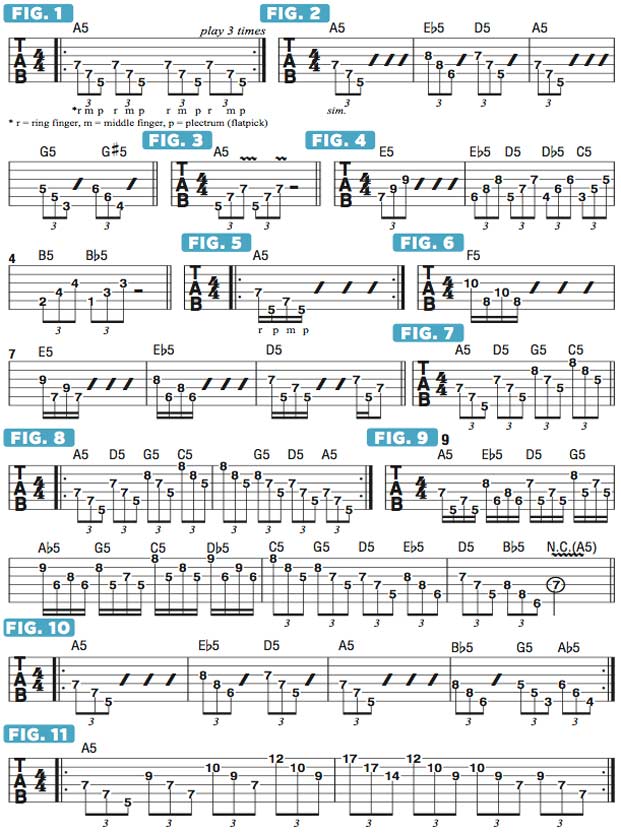Hybrid Picking Power-Chord Arpeggios
Learn some cool ways to create angular single-note arpeggios that are based on root-fifth-octave power chord shapes.

All rock guitar players are familiar with root-fifth-octave power chord shapes.
In this column, I’d like to show you some cool ways to create angular single-note arpeggios that are based on these familiar shapes, using hybrid picking, the technique that incorporates both flatpicked downstrokes and fingerpicking with the middle and ring fingers.
As you will see, hybrid picking greatly facilitates one-note-per-string patterns and the continual string crossing that they entail.
In FIGURE 1, I fret a standard A5 power chord shape on the bottom three strings in fifth position and repeatedly play the notes in descending order and an eighth-note triplet rhythm. I use my ring finger to pick the high A root note on the D string, the middle finger to pick E, the fifth of the power chord, on the A string and the plectrum to pick the low A root on the bottom string.
As shown in FIGURE 2, we can easily move this idea over to the A, D and G strings, using the same root-fifth-octave shape to sound other power chord arpeggios in the same triplet rhythm.
Now let’s try reversing the order in which the notes of our A5 arpeggio are played. In FIGURE 3, the low A root is sounded first, with the pick, followed by the fifth, E, picked with the middle finger, and then the high A root, picked with the ring finger. Just as we had done in FIGURE 2, we can easily move this three-note shape over to the A, D and G strings to play the chromatically descending power-chord arpeggios shown in FIGURE 4.
Another melodic variation, shown in FIGURE 5, is to pick the A5 arpeggio in a 16th-note rhythm, using the four-note sequence ring-pick-middle-pick. Notice that the low A root note is played twice within the four-note pattern. FIGURE 6 shows the same picking pattern and shape applied to descending power-chord arpeggios on the next higher three-string group.
One especially cool and useful approach for lead playing in the key of A minor is to build root-fifth-octave power-chord arpeggios off of the notes of the A minor pentatonic scale (A C D E G), as demonstrated in FIGURES 7 and 8. FIGURES 9 and 10 offer examples of how to use this hybrid-picked-arpeggios technique to outline shifting power chord progressions that venture outside A minor pentatonic.
In FIGURE 11, I use the technique to sound five different inversions of an A5 power chord up and across the fretboard, using quick position shifts on each beat. In each three-note group, the only notes played are A and E. Once you have these shapes and patterns comfortably under your fingers, try applying them to other power-chord progressions you know. Also try using other hybrid-picking patterns, such as pick-middle-pick-ring, or pick-ring-pick-middle.

Get The Pick Newsletter
All the latest guitar news, interviews, lessons, reviews, deals and more, direct to your inbox!









![Joe Bonamassa [left] wears a deep blue suit and polka-dotted shirt and plays his green refin Strat; the late Irish blues legend Rory Gallagher [right] screams and inflicts some punishment on his heavily worn number one Stratocaster.](https://cdn.mos.cms.futurecdn.net/cw28h7UBcTVfTLs7p7eiLe.jpg)
